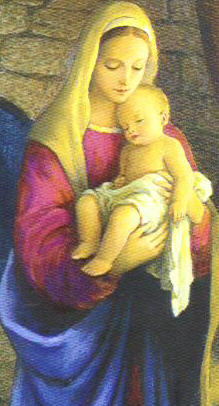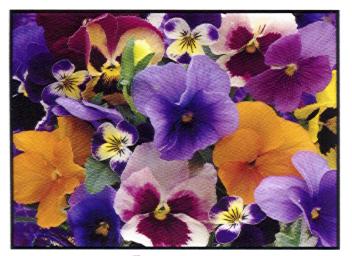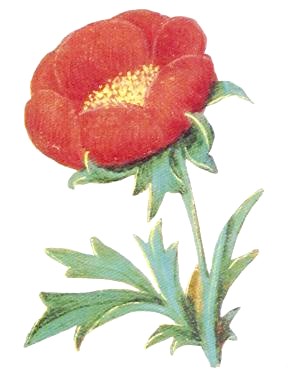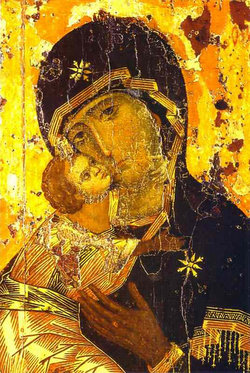Who is she that cometh forth as the morning rising, fair as the moon, bright as the sun?
As the rainbow giving light in the bright clouds. And as the flower of the roses in the days of spring.
O Virgin, your glory transcends all created things.
What, in effect, compares to your nobility,
O Mother of God the Word?
To what in all creation will I compare you?
Angels of god and archangels are sublime,
But how much you transcend them, O Mary! (St. Athanasius)
O divine, and now heavenly, Virgin, how can we express all things which pertain to you? How can we glorify the treasury of all glory? Merely your memory sanctifies whoever keeps it, and a mere movement towards you makes the mind more translucent, and you exalt it straightway to the Divine. Richly, therefore, bestow your mercy and your graces upon all your people, this yours inheritance, O Lady!
This crowning of Mary, dates back to mediæval times. Then May day was, and is in some places to-day such as Oxford, a merry day, a day of garland, of dancing and of flowers, and indeed of queening. "She came adorned hither like a sweet May" (Shakespeare, Richard II.V.1.79). In mediæval days it was quite an honour for the girl of the village to be "Queen of May" for the games and for dances such as the Maypole. "For I'm to be Queen o' the May, mother, I'm to be Queen o' the May" (Tennyson, May Queene).
Hail, holy Queen, mother of mercy,
Hail, holy Queen, treasure of divine grace,
Hail, holy Queen, advocate of sinners,
Hail, holy Queen, mother of God.
Gaelic Litany to Mary. C. 750 Anonymous
O Great Mary.
O Mary, greatest of Maries.
O Greatest of Women.
O Queen of Angels.
O Mistress of the Heavens.
O Woman full and replete with the grace of the Holy Ghost.
O Blessed and Most Blessed.
O Mother of Eternal Glory.
O Mother of the heavenly and earthly Church.
Pray for us
O Mother of Love and Indulgence.
O Mother of the Golden Heights.
O Honour of the Sky.
O Sign of Tranquillity.
O Gate of Heaven.
O Golden Casket.
O Couch of Love and Mercy.
O Temple of Divinity.
O Beauty of Virgins.
Pray for us
O Cleansing of the Sins.
O Purifying of Souls.
O Mother of Orphans.
O Breast of the Infants.
O Solace of the Wretched.
O Star of the Sea.
O Handmaid of the Lord.
O Mother of Christ.
Pray for us
O Resort of the Lord.
O Graceful like the Dove.
O Serene like the Moon.
O Resplendent like the Sun.
O Canceller of Eve's disgrace.
O Regeneration of Life.
O Beauty of Women.
O Leader of the Virgins.
O Enclosed Garden.
O Closely Locked Fountain.
Pray for us
O Mother of God.
O Perpetual Virgin.
O Holy Virgin.
O Prudent Virgin.
O Serene Virgin.
O Chaste Virgin.
O Temple of the Living God.
O Royal Throne of the Eternal King.
O Sanctuary of the Holy Ghost.
O Virgin of the Root of Jesse.
O Cedar of Mount Lebanon.
O Cypress of Mount Sion.
O Crimson Rose of the Land of Jacob.
O Blooming like the Palm Tree.
O Fruitful like the Olive Tree.
Pray for us.
O Glorious Son-bearer.
O Light of Nazareth.
O Glory of Jerusalem.
O Beauty of the World.
O Noblest-Born of the Christian Flock.
O Queen of Life.
O Ladder of Heaven.
Pray for us O Holy Mother of God that
we may be worthy of the promises of your Son.
In his poem May Magnificat, the Jesuit poet Gerard Manley Hopkins associated the blessed Virgin with the fullness of life in all creation during the month of May. It is the pinnacle of spring freshness and finery, and so nature decked in all her bridal loveliness reigns just as Mary does in heaven. Meadow upon meadow is over brimming in earth's generosity of motherhood as ducklings waddle, bunnies scurry, and chicks chirp. Motherhood is at her grandest, or almost, for was not that achieved by a Jewish maiden ere so long ago?
May is Mary's month, and I
Muse at that and wonder why:
Candlemas, Lady Day;
But the Lady Month, May,
Why fasten that upon her,
With a feasting in her honour?
Is it only its being brighter
Than the most are must delight her?
Is it opportunest
And flowers finds soonest?
Ask of her, the mighty mother:
Her reply puts this other
Flesh and fleece, fur and feather
Grass and greenworld all together;
Stareyed strawberrybreasted
Throstle above her nested
Cluster of bugle blue eggs thin
Forms and warms the life within;
And bird and blossom swell
In sod or sheath or shell.
All things rising, all things sizing
Mary sees, sympathising
With that world of good,
Nature's motherhood.
Their magnifying of each its kind
With delight calls to mind
How she did in her stored
Magnify the Lord.
Well but there was more than this:
Spring's universal bliss
Much, had much to say
To offering Mary May.
When dropofbloodandfoamdapple
Bloom lights the orchardapple
And thicket and thorp are merry
With silversurfed cherry
And azuringover greybell makes
Wood banks and brakes wash wet like lakes
And magic cuckoocall
Caps, clears, and clinches all
This ecstasy all through mothering earth
Tells Mary her mirth till Christ's birth
To remember and exultation
In God who was her salvation.
Mary's month of May is also associated with flowers not only those for her garland, but as a means of meditation on Mary whose life teaches us so much about our relationship with God. Accordingly in some parts of the world on each day of May a different flower, bearing some association with the life of Mary is the source for meditation. Indeed it has been suggested that all flowers that bloom in the Madonna's month are especially dedicated to her, and of these the rose holds a noble place. In Italy all through the month of May everyone who can secure roses, places them in his oratory or on a table.
This devotion was associated with Mary Gardens. These were very popular in mediæval times, and still exist to-day, where those flowers associated with Mary such as "The rose of charity, the lily of chastity, the violet of humility and the golden gillyflower of heaven" as listed by St. Bernard were grown to honour our dear Mother, and symbolise some aspect of Mary's life or character. Within each garden there was a statue of Mary crowned with leafy sprigs and nearby the Christ Child surrounded by flowers. Of course many of these Mary gardens were part of monastic landscapes. St. Benedict had a rose garden from which the word "Rosary" comes, but the first known garden dedicated to Mary was planted and tended by the Irish, St. Fiarce around an oratory to Our Lady in his hospice for the poor and infirm in France in 7thC.
However flowers associated with Mary are deeply intertwined with ancient lore that can be traced back beyond the Christian era. In heathen mythology almost every common plant was the emblem of a god; every tree was the abode of a nymph. The laurel was sacred to Apollo in memory of Daphne who was changed into a laurel while escaping his advances. The anemone, poppy and violet were dedicated to Venus, the narcissus and maidenhair fern to Prosperpine, the willow to Ceres, the pink to Jove and the lily, crocus and asphodel to Juno. The lily was also sacred to Buddha and Brahma, the basil to Vishnu and the henna plant to Mahomet.
Within the Christian tradition flower symbolism begins with the prophecy of Isaiah of the birth of God Incarnate as the blossoming Rod of Jesse. The blossoming vine with flower was also seen to represent the birth-giving of the Blessed Virgin Mary; and in celebration of this, the Church Fathers attributed to her all the flower references in the Sapiential Books of the Bible. Later on the Venerable Bede of the 8th C. had especially taken the lily with its translucent white petals as symbolising Mary's pure body as she was assumed into heaven, and its golden anthers to the glorious resplendence of her soul. In the Middle Ages Marian flower symbolism was then extended to a "galaxy" of flowers of the medieval countrysides, following the traditions of SS. Bernard, Francis and later Francis de Sales, and was promoted by wandering friars and minstrels. This flower symbolism corresponded with more emphatic recognition of Mary's position in the divine plan of Creation, Salvation and Kingdom. Poets too linked aspects of Mary's life with flowers. Chaucer simply referred to her as the "Flower of flowers". Dante's image of the Virgin as "the rose wherein the Divine Word became incarnate", has been centrally portrayed in the images of the Virgin and Child in Rose Windows of medieval cathedrals, such as Chartres, and in the Christmas carol, "Lo, How a Rose e'er Blooming", and reference in carols to Mary as the "mystic Rose".
Each garden gives her glory, chants her praise
Even in harsh and hostile places where
Men have forgotten gentleness and prayer,
And what still canticles waft through their days.
Yet in the Western Church it is the Lily that is mostly associated with the Mother of God.
"Send forth flowers as the Lily,
and yield a fragrance,
And bring forth leaves in grace,
and praise with canticles,
And bless the Lord in his works."
Sirach 39:13-14 (Ecclesiasticus 39:18-19)
Lilies of one kind or another symbolise the major feasts of Mary. In depicting the Annunciation, early painters represented the angel Gabriel carrying either a sceptre or a spray of olive but by the time of early Renaissance the church instructed artists always to depict him with a spray of madonna lilies in his hand, and this edict was followed scrupulously in the later period of Italian church art. Usually the spray consisted of three blossoms, suggesting the Trinity. Sometimes this lily for the 25th March is referred to as the Annunciation Lily, symbolic of innocence, purity and virginity. At the Feast of the Annunciation today, white irises, flowering almonds and white narcissi are also used.
The Madonna lily is also associated with the Visitation when Mary strode across the countryside to visit her aged cousin Elizabeth, also with child. Again practically every painting depicting this meeting of joy depicts three blossoms of lilies. The pure white sepals are symbolic of her spotless body and the six golden anthers of her soul sparkling with divine light.
Furthermore the Madonna lily symbolises Mary's immaculate conception, as does the lily among thorns. The Assumption Lily, a lily that blooms at the time of the Dormition on the 15th August represents the Assumption, as does the white virgin's bower, widely used. The rose also depicts this miraculous ascent of Mary into heaven.
The Lily-of-the Valley represents Mary's humility throughout all her life, beginning with her receiving graciously the message of Gabriel.
Mary, great Mary, most blessed of all, greatest among all women, great Lady, great beyond measure,
I long to love you with all my heart,
I wish to praise you with my lips,
I desire to venerate you in my mind,
I love to pray to you from my inner being,
I commit myself wholly to your protection.
All nature is created by God and God is born of Mary.
God created all things, and Mary gave birth to God.
God who made everything made himself from Mary, and so he refashioned everything he had made.
The One who was able to make all things out of nothing declined to make it by force but first became Mary's son.
As God is the Father of all created things, so Mary is the mother of all re-created things.
God is the Father of all that is established, and Mary is the mother of all that re-established.
For God gave birth to the Son through whom all things were made and Mary gave birth to the Son through whom all are saved.
God brought forth him without whom nothing is,
Mary bore him without whom nothing is good.
O truly, 'the Lord is with thee,' to whom the Lord gave himself, that all nature in thee might be in him.
-Anselm, Prayer to Mary
In the Eastern Church it is the rose, both red and white that is the emblem of Mary. The Rose symbolises the young Virgin giving birth to the Christ, the Divine Word made incarnate, and the Messiah as the suffering Servant. As Mother of the Church Mary continues to give birth to Christ in the hearts of others that they may be converted and baptized, as his members.
More honourable than the cherubim
There are of course many other flowers and vines associated with Mary's feast and aspects of her life. Those associated with the Annunciation include the Periwinkle, "Virgin Flower", as its blue colour recall her fullness of grace, and the Columbine, symbol of the dove of the Holy Spirit, Mary's overshadowing, indwelling, divine Spouse. Those depicting the Visitation are the Monkshood, "Our Lady's Slipper", symbol of Mary's graceful Visitation trip to visit Elizabeth in the hill country: "All her steps were most beauteous", and Thistle-Down from its graceful movement in air currents. The Nativity is depicted by "Lady-Lords". This arum foliage with its large spathe, enclosing a fleshly spike represents a floral symbol of the Madonna- Mother and Child enthroned, and was adopted by the Church after the Council of Ephesus, which declared Mary as Theotokos, Mother of God. The Nativity is also denoted by the Daisy, "Mary's Flower of God" (Jesus), whilst Candlemass has the snowdrop, often in full bloom by the 2nd February, depicting her purity and chastity. The Candlemass bells ring out Simeon's prophecy that a sword would pierce Mary's heart. And so the snowdrop is also associated with those commemorations of Our Lady of Sorrows. The tiny soul-piercing spears of the snowdrop foliage together with the spear-like foliage of the Iris symbolise Mary's sorrow and lament at the foot of the cross.
Rejoice, O Virgin Theotokos, full of grace!
From you shone the Sun of Righteousness Christ our God
enlightening those who sat in darkness.
Hail O Woman full of grace,
Virgin and Mother of God from you has risen the Sun of Justice,
Rejoice and be glad O righteous elder, you accepted in your arms the Redeemer of the World.
Mistletoe, ivy and all vines that entwine symbolise Mary's fullness with the Holy Trinity, "God with her". This was necessary for her Divine Maternity that was initiated through her fullness with the overshadowing, indwelling, conceiving Holy Spirit; whereby she became the Mother of God - co-parent, with the God the Father, of God the Son incarnate. Her fullness with the Divinity was then further manifested in her intimate union and close cooperation with Jesus as mother, and as companion in his ministry, Passion, and death on the Cross. The vines also represent the union and close cooperation of Mary with Christ, the redeeming Divine Son, Advocate, Intercessor,
The Mistletoe is also a traditional Immaculate Conception symbol because of its "miraculous" greening and fruiting in winter. But by its symbiotic union with the winter tree trunks, symbols of the Cross, around which it entwines, and from which it obtains its sustenance, unites Mary with her Son's sufferings at Calvary.
There are flowers symbolising characteristics of the blessed Maid and of her life. The pansy symbolises our Lady's delight in the Trinity, which was first revealed to her. The strawberry, as it continues in flower while bearing fruit, symbolizes Mary's perpetual virginity. The violet reminds us of Mary's modesty and humility. The tiny white pins in the flower heads of sweet scabious, reveals Mary's domesticity, especially in her sewing garments for her beloved Son. Snapdragon blooms also envisage the home of Mary where Jesus plays under the loving care and prayers of his Mother. Impatiens has been named Mother Love from the constancy of its blooms during the entire period from spring to frost, depicting the constancy of Mary's love for her Divine Son and Lord, and for us too, her spiritual children. Blooms of petunias were named Our Lady's Praises from their perceived resemblance to lips at prayer, and are thus associated with Mary's prayers as she "magnifies the Lord." May our prayers, too, rise to Our Lady and God as pure spiritual bouquets of love.
"O incomparable Virgin! Immaculate Virgin! Delight of the
Blessed Trinity, admiration of all angels and saints, you
are the joy of heaven: Morning Star, Rose blossoming in
springtime, Immaculate Lily, tall and graceful Iris,
sweet-smelling Violet, Garden Enclosed kept for the delight
of the King of Heaven . . . We salute you and rejoice
at the sight of the gifts bestowed upon you by God
and of the prerogatives with which he has crowned you."
We hail you Mary, for in your virginal womb you held the one whom the heavens themselves cannot contain, one through whom the Trinity is glorified and worshipped throughout the world; through whom the heavens exult; through whom angels and archangels rejoice; through whom demons are put to flight; through whom the tempter was thrown out of heaven; through whom fallen creation is raised up to the heavens; through whom the whole world, held captive by idolatry, has now come to know the truth; through whom holy baptism is given to those who believe, anointing them with the 'oil of gladness'; through whom churches have been founded throughout the world; through whom the nations have been converted.
In the early Church, the Fathers emphasised that Mary's honour was not so much because she carried the son of God in her womb, but that she heard God's word and kept it. She held the Word made flesh, her beloved Son, in her heart as she carried him in her body during her pregnancy, but she allowed His word to transform her life.
As St. Augustine's expressed it:
Mary heard God's word and kept it, and so (was) blessed. She kept God's truth in her mind, a nobler thing than carrying his body in her womb. The truth and the body were both Christ: he was kept in Mary's mind insofar as he is truth, he was carried in her womb insofar as he is man; but what is kept in the mind is of a higher order than what is carried in the womb.
Hail you highly favoured one, the Lord is with, blessed art you amongst women and the blessed is the fruit of your womb Jesus
Holy Mary, Mother of God pray for us sinner now and at the hour of our death.
One of the joyful mysteries is Mary's visit to her cousin after she knew that was to be the Mother of God. That feast we shall celebrate on Thursday. Her response to Elizabeth's greetings, Magnificat is immortal and indeed is sung throughout the world each evening in great cathedrals, thatched churches, humble huts and on the restless seas unceasingly.
"My soul proclaims the greatness of the Lord, and my spirit rejoices in God my Saviour." With these words Mary first acknowledged the special gifts she has been given. These words of praise, therefore, may be fittingly uttered by all of God's creatures, but it is especially appropriate that they should be spoken by the blessed Mother of God. She alone was chosen, and she burned with spiritual love for the son she so joyously conceived.
"For the Almighty has done great things for me" Mary attributes nothing to her own merits. She refers all her greatness to the gift of the one whose essence is power and whose nature is greatness, for he fills with greatness and strength the small and weak who believe in him.
"and holy is his name." Mary advocates that all who would receive his words, must believe and call upon his name. For all can share in everlasting holiness and salvation through the fruit of her womb. (Bede)
Hail, O Lady, unique gateway through whom the Lord alone has passed! Hail, O you who, through your maternity, have shattered the locks of Hades! Hail, divine access towards salvation for the saved, O you so perfectly worthy of our praise!
Let us delight in her purity of soul and body, for she next to God surpasses all in purity. Let us show our love for her by compassion and kindness towards the poor. For if mercy is the best worship of God, who will refuse to show His Mother devotion in the same way? She opened to us the unspeakable abyss of God's love for us. Through her the old enmity against the Creator is destroyed. Through her our reconciliation with Him is strengthened, peace and grace are given to us, men are the companions of angels, and we, who were in dishonour, are made the children of God. From her we have plucked the fruit of 1ife. From her we have received the seed of immortality. She is the channel of all our goods. In her God was man and man was God. What more marvellous or more blessed? Let our souls rejoice in the Ark of God; Let us dance in spirit with David; and with Gabriel, the great archangel, let us exclaim, "Hail, full of grace, the Lord is with thee.
O Theotokos, Virgin Mary, it is indeed a dread and ineffable mystery, what has been done in you.
For you, indeed, gave birth to the Word, who is the cause of all things, and Who is the cause of all things, and Who was incarnated by the Holy Spirit, beyond any cause or reason.
For from you, who remained unchangeable, He received flesh of His own divine immutable and unaltered nature.
O VIRGIN Mother of God, the Maker of heaven and earth covered you with his shadow, O Pure One, and came to dwell in your womb, and taught us all to cry out to you in prayer:
Hail, O pillar of Virginity;
Hail, O gate of salvation.
Hail, O source of our rebirth in your Son;
Hail, O bestower of divine beneficence.
Hail, for you did regenerate our fallen race;
Hail, for you did instill the truth in minds lacking truth.
Hail, for you destroyed the work of corrupter of souls;
Hail, for you did give birth to the sower of purity.
Hail, O holy chamber of virginal wedlock;
Hail, O reconciliation of the faithful with God.
Hail, O gracious instructress of virgins;
Hail, O adornment of the souls of Saints.
Hail, O Virgin and Bride ever pure!
Hail, O Virgin and Bride ever pure!
Let every human being take up a torch and let him dance in spirit, and let the immaterial sprite celebrate this holy feast of the Mother of God and cry out: Rejoice, O all blessed and pure and ever virgin Theotokos. O Most holy Theotokos, save us!
O Maiden, deliver us who through you have become partakers of the eternal joy, so that we may be worthy to hail you: deliver us from all temptations, from cruel assaults, and from all the miseries that threaten us because of our many sins! O Most holy Theotokos, save us!
Let us reverently stand in the house of God, and let us sing: Hail, Queen of the universe! Hail, Mary, the Lady of us all! Hail, only immaculate one, most beautiful among women! Hail, vessel who has contained the everlasting perfume that was poured into you! Glory be to the Father and to the Son and to the Holy Spirit.
Hail, eternal Virgin, dove in whom Mercy was born! Hail, pride of every saint, and crown of every martyr! Hail, divine beauty of the just, salvation unto all of us the faithful! Now and always and for ever and ever. Amen.
Marianne Dorman







